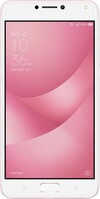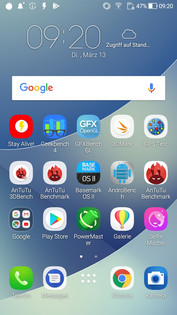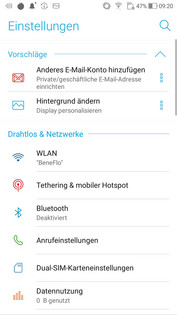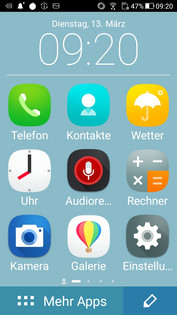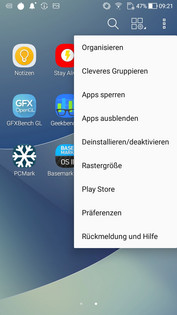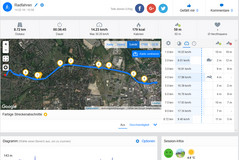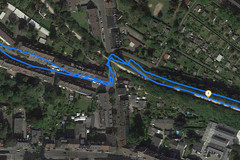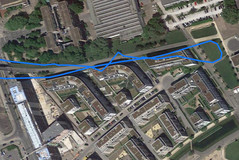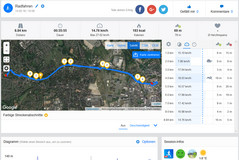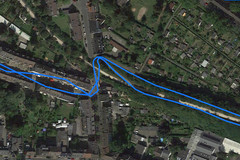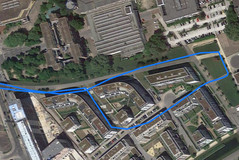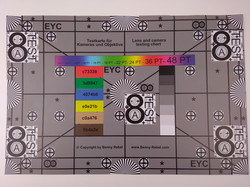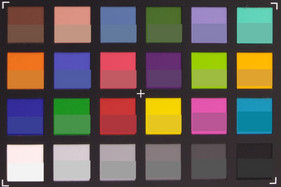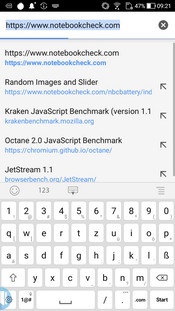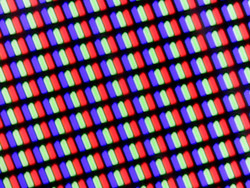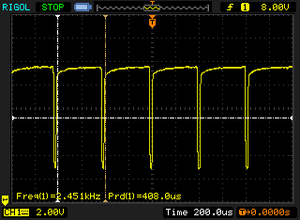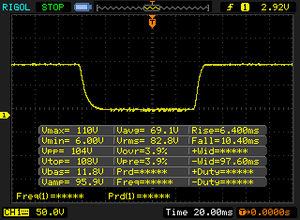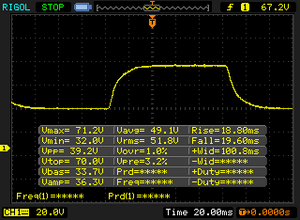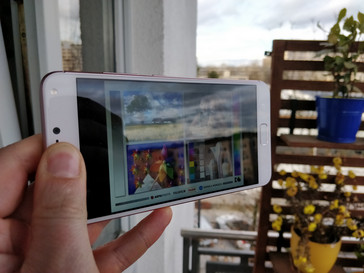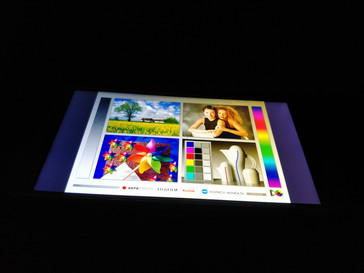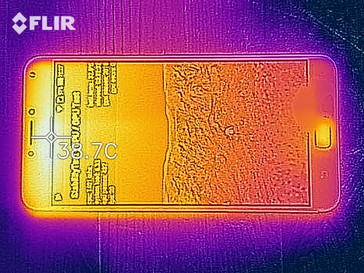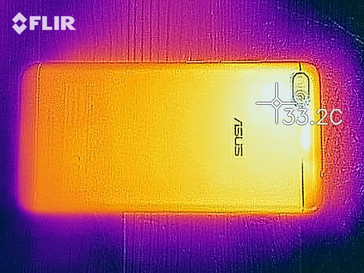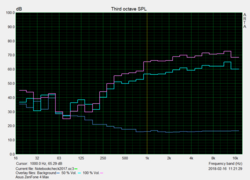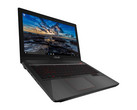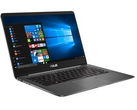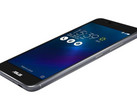Asus ZenFone 4 Max ZC554KL Smartphone Review

Just over a year ago, we had the Asus ZenFone 3 Max in review - a smartphone that prided itself on its particularly large battery. Unfortunately, the device’s performance was subpar and inferior to similarly priced competing smartphones. This year’s successor is supposed to be better in every single aspect, and it even features a dual-camera setup with a wide-angle lens on top. A smaller 5.2-inch ZenFone 4 Max device, model number ZC520TL, is also available. Not only does it have a smaller screen, its battery capacity is also just 4,100 mAh, and it only features a quad-core instead of our review unit’s octa-core CPU.
The ZenFone 4 Max’s main competitors are other smartphones at similar price points, such as the Wiko WIM or the Samsung Galaxy J7. The Motorola Moto E4 Plus is also a worthy competitor - it is much cheaper, but equipped with a similarly large battery. And we are obviously also going to include last year’s Asus ZenFone 3 Max in order to witness any improvements or regressions first-hand.
At the time of writing, the Asus ZenFone 4 Max ZC554KL was available for $200 at various retail outlets.
Case
Compared to its 5.2-inch predecessor, the new model has grown slightly now to 5.5 inches. Therefore, it is not just bigger than its predecessor, but with its average thickness of 8.9 mm (~0.35 in) also quite bulky for a 5.5-inch smartphone. The rear cover is made of aluminum, and our review unit was clad in gentle Rose Gold. Other available colors include Gold and Black, and only the latter features a black front while the other two models are white instead. All things considered, the smartphone feels good in hand, and it is fairly soft and ergonomic thanks to its rounded edges.
Applying pressure to either side has immediate effects on the display, and we were able to warp the case slightly, which caused a visible ripple effect on the display. Overall, the build quality is quite decent. The metal case looks fairly premium, but the smartphone’s design is by no means especial in any way.
Connectivity
One of the ZenFone 4 Max’s defining features is its triple slot for two SIM cards and one MicroSD (up to 256 GB card) at the same time. Unfortunately, MicroSD cards can only be formatted as external storage, and thus cannot be used to offload and store apps.
Equipped with 3 GB of RAM and 32 GB of storage space, the 4 Max is identical to its own predecessor. It is not uncommon to see smartphones with just 16 GB of storage in the 4 Max’s price range. It is thus more than adequately equipped. It also supports USB OTG, but unfortunately lacks an NFC chip.
Software
The ZenFone 4 Max is running Android 7.1.1 out of the box with up-to-date Android security patches (3/1/2018) at the time of writing. An update to Android 8 has already been announced, but Asus has not yet specified when exactly that is going to happen.
Asus’s own in-house user interface - ZenUI 4 - is preloaded on the 4 Max, and it comes with some useful apps for extra security or smartphone maintenance as well as an app called “Selfie Master”, which does exactly what the name suggests. The user interface supports themes. Various Facebook apps are preloaded as well, but these can be uninstalled if necessary.
Communication and GPS
Wi-Fi support is limited to 802.11b/g/n only, and the Wi-Fi chip turned out to be quite lethargic to boot (just like its predecessor). Connected to our Linksys EA8500 reference router, the 4 Max only managed transfer speeds of 52.7 Mbps (receive). It does not support the less commonly used 5 GHz bands.
LTE support is limited to just 7 bands and a maximum download speed of 150 Mbps - the 4 Max is thus at the lower end of the spectrum. Using the 4 Max outside of Europe will be a major challenge due to the different LTE frequencies used in other regions of the world.
Indoors, the device had absolutely no GPS connectivity whatsoever, not even when standing at the window. Outside, GPS reception and accuracy (6 m/~20 ft) was decent. We determine GPS accuracy by taking every smartphone on a bicycle tour during which it is up against a professional Garmin Edge 500 GPS unit. Overall, the ZenFone 4 Max did fairly well with only minor deviations and departures from the actual track here and there. Thus, the GPS is more than decent enough for occasional use.
Telephony and Call Quality
The telephone app has been modified by Asus. The keypad can be found at the bottom right underneath a list of recent calls. Access to contacts and groups is implemented via a tab bar at the top of the display.
Call quality was very good for a device this cheap, and we were particularly impressed by the high maximum earphone volume and the largely non-existent distortions at maximum volume. The microphone was very sensitive and had trouble with loud voices, but it worked just fine otherwise. Speakerphone performance was loud and clear, albeit not as loud as earphone performance. We did notice some static here and there, but by and large, speakerphone quality was more than decent.
Cameras
The ZenFone 4 Max does not claim to be a camera phone. Instead, its main emphasis is put on the large battery. Nevertheless, it features a dual-lens camera with a wide-angle lens at the back and a single-lens camera with LED flash at the front. The main camera’s resolution of 13 MP is accompanied by the wide-angle camera’s 5 MP sensor. It is worth noting that the latter is so wide that its photos show a very pronounced fish-eye effect, as can be seen on the photo to the right.
Back light photos turned out surprisingly well despite the loss of details in the sky. That said, photos were subjectively rather pale and seemed to have a red tint to them. A higher-quality camera, such as the one on the Google Pixel 2, will produce images much richer in detail. Poor lighting was a challenge for the ZenFone 4 Max, and once again higher-quality cameras did much better in these conditions.
Videos are recorded in FHD at 30 FPS, and as with the photos, the videos also seem somewhat pale and dull. Sudden changes in lighting were processed with a noticeable lag.
Assuming adequate lighting, the 8 MP front-facing camera did a very decent job. Given its fix-focus lens one has to carefully choose the distance between the object and the lens, though.
The extensive preloaded photo software is also a plus.
The red tint that we have noticed in our outdoor photos was also found on our lab photos taken under normalized conditions. Image focus was excellent, although text against red backgrounds was somewhat blurry and scruffy. We have also noticed occasional artifacts around the edges, and color representation was decent, save for occasional deviations in greens. Color accuracy was acceptable, and the red tint was most visible on white surfaces.
Accessories and Warranty
The box contains the power supply, a USB cable, a SIM tool, a headset, and a USB OTG dongle; the only thing missing seems to be a protective case. Speaking of which: at the time of writing, there were no model-specific accessories available directly from Asus.
The phone is sold with a 24-month limited warranty. Please see our Guarantees, Return Policies and Warranties FAQ for country-specific information.
Input Devices & Handling
Handling was very smooth overall. The touchscreen was very sensitive up to its edges and corners. A fingerprint reader capable of waking the phone from standby mode is located right underneath the display, and responded to our fingers quickly and reliably. Once unlocked, the button the reader is integrated into served as home button, enframed on either side by capacitive back and app switcher buttons. The home button as well as the right capacitive button can be remapped in the settings.
Various gestures can be found under “ZenMotion”. These include, but are not limited to double tapping to activate standby, flipping the phone over to mute all sounds, or automatically answering phone calls.
A simple mode and kid’s mode are also available, and they allow further customizations for one’s individual requirements and needs.
Display
The ZenFone 4 Max’s display resolution of just 1280x720 is fairly low considering its massive 5.5-inch screen even when taking its low price into account. Similarly priced phones often feature FHD displays instead. At just 394 nits, the average brightness was also quite low - the Lenovo Moto G5 Plus was more than 100 nits brighter. APL50 further confirmed our initial measurements. At 87%, the brightness distribution was decent enough for a somewhat uniform color representation, but it was far from ideal given that differences in display brightness were visible to the naked eye.
| |||||||||||||||||||||||||
Brightness Distribution: 87 %
Center on Battery: 417 cd/m²
Contrast: 802:1 (Black: 0.52 cd/m²)
ΔE ColorChecker Calman: 5.8 | ∀{0.5-29.43 Ø4.78}
ΔE Greyscale Calman: 5.2 | ∀{0.09-98 Ø5}
Gamma: 2.76
CCT: 7467 K
| Asus ZenFone 4 Max ZC554KL IPS, 1280x720, 5.5" | Lenovo Moto E4 Plus IPS, 1280x720, 5.5" | Lenovo Moto G5 Plus IPS, 1920x1080, 5.2" | Wiko WIM AMOLED, 1920x1080, 5.5" | Samsung Galaxy J7 2017 Super AMOLED, 1920x1080, 5.5" | Asus Zenfone 3 Max ZC520TL IPS, 1280x720, 5.2" | |
|---|---|---|---|---|---|---|
| Screen | 17% | 20% | -8% | 34% | 14% | |
| Brightness middle (cd/m²) | 417 | 425 2% | 503 21% | 344 -18% | 454 9% | 507 22% |
| Brightness (cd/m²) | 394 | 425 8% | 495 26% | 353 -10% | 463 18% | 474 20% |
| Brightness Distribution (%) | 87 | 93 7% | 96 10% | 90 3% | 86 -1% | 85 -2% |
| Black Level * (cd/m²) | 0.52 | 0.37 29% | 0.31 40% | 0.53 -2% | ||
| Contrast (:1) | 802 | 1149 43% | 1623 102% | 957 19% | ||
| Colorchecker dE 2000 * | 5.8 | 4.7 19% | 6.2 -7% | 5.7 2% | 2 66% | 4.7 19% |
| Colorchecker dE 2000 max. * | 9.5 | 8.3 13% | 9.8 -3% | 12.2 -28% | 5.3 44% | 7.2 24% |
| Greyscale dE 2000 * | 5.2 | 4.6 12% | 6.8 -31% | 5.1 2% | 1.7 67% | 4.8 8% |
| Gamma | 2.76 80% | 2.17 101% | 2.33 94% | 2.73 81% | 2.1 105% | 2.25 98% |
| CCT | 7467 87% | 7445 87% | 8113 80% | 7407 88% | 6394 102% | 6441 101% |
* ... smaller is better
Screen Flickering / PWM (Pulse-Width Modulation)
| Screen flickering / PWM detected | 2451 Hz | ≤ 23 % brightness setting | |
The display backlight flickers at 2451 Hz (worst case, e.g., utilizing PWM) Flickering detected at a brightness setting of 23 % and below. There should be no flickering or PWM above this brightness setting. The frequency of 2451 Hz is quite high, so most users sensitive to PWM should not notice any flickering. In comparison: 53 % of all tested devices do not use PWM to dim the display. If PWM was detected, an average of 8098 (minimum: 5 - maximum: 343500) Hz was measured. | |||
Due to a rather high black level of 0.52 nits the display’s contrast ratio was just 802:1, and thus the lowest of all candidates in our test group. In addition, we found PWM flickering at brightness levels of 23% and below. Fortunately, the frequency was high enough to not cause any issues.
Color accuracy was pretty poor, but at least sRGB color space coverage was very good. Gray scale representation suffered from a quite severe blue tint.
Display Response Times
| ↔ Response Time Black to White | ||
|---|---|---|
| 16.8 ms ... rise ↗ and fall ↘ combined | ↗ 6.4 ms rise | |
| ↘ 10.4 ms fall | ||
| The screen shows good response rates in our tests, but may be too slow for competitive gamers. In comparison, all tested devices range from 0.1 (minimum) to 240 (maximum) ms. » 37 % of all devices are better. This means that the measured response time is better than the average of all tested devices (20.2 ms). | ||
| ↔ Response Time 50% Grey to 80% Grey | ||
| 38.4 ms ... rise ↗ and fall ↘ combined | ↗ 18.8 ms rise | |
| ↘ 19.6 ms fall | ||
| The screen shows slow response rates in our tests and will be unsatisfactory for gamers. In comparison, all tested devices range from 0.165 (minimum) to 636 (maximum) ms. » 56 % of all devices are better. This means that the measured response time is worse than the average of all tested devices (31.6 ms). | ||
Despite the fast and reliable ambient light sensor, outdoor usage turned out to be something of a mixed bag due to the display’s low maximum brightness. The screen is highly reflective, which was particularly bothersome on bright sunny days.
Viewing angles were decent, and we did not notice any signs of loss of brightness or deviation of colors, even at acute angles.
Performance
Granted, the Qualcomm Snapdragon 430 is not the fastest SoC, but it is still a massive improvement over last year’s ZenFone 3 Max. Looking at the devices in our test group, the 4 Max was significantly faster than the Motorola Moto E4 Plus but practically outclassed by the Moto G5 Plus (between 20 and 40% depending on benchmark). The 4 Max’s Qualcomm Adreno 505 GPU is also a noticeable improvement over last year’s model; while it beat the Moto E4 Plus hands down, it was unable to keep up with the rest of the field.
Browser benchmark results paint a similar picture. The ZenFone 3 Max and the Moto E4 Plus were lagging behind noticeably while the other competitors were significantly faster. Website load times on the ZenFone 4 Max were pretty long overall, but the SoC is fast enough for decently written HTML5 pages.
| JetStream 1.1 - Total Score | |
| Lenovo Moto G5 Plus (Chrome 57) | |
| Wiko WIM (Chrome Version 59) | |
| Samsung Galaxy J7 2017 (Samsung Browser 5.4) | |
| Average Qualcomm Snapdragon 430 (MSM8937) (17.6 - 21.5, n=16) | |
| Asus ZenFone 4 Max ZC554KL (Chrome 64) | |
| Asus Zenfone 3 Max ZC520TL (Chrome 55) | |
| Lenovo Moto E4 Plus (Chrome 60) | |
| Octane V2 - Total Score | |
| Average of class Smartphone (2228 - 121337, n=197, last 2 years) | |
| Wiko WIM (Chrome Version 59) | |
| Samsung Galaxy J7 2017 (Samsung Browser 5.4) | |
| Lenovo Moto G5 Plus (Chrome 57) | |
| Average Qualcomm Snapdragon 430 (MSM8937) (2604 - 3438, n=18) | |
| Asus ZenFone 4 Max ZC554KL (Chrome 64) | |
| Asus Zenfone 3 Max ZC520TL (Chrome 55) | |
| Lenovo Moto E4 Plus (Chrome 60) | |
| Mozilla Kraken 1.1 - Total | |
| Lenovo Moto E4 Plus (Chrome 60) | |
| Asus Zenfone 3 Max ZC520TL (Chrome 55) | |
| Asus ZenFone 4 Max ZC554KL (Chrome 64) | |
| Average Qualcomm Snapdragon 430 (MSM8937) (10396 - 14709, n=18) | |
| Wiko WIM (Chrome Version 59) | |
| Lenovo Moto G5 Plus (Chrome 57) | |
| Samsung Galaxy J7 2017 (Samsung Browser 5.4) | |
| Average of class Smartphone (257 - 28190, n=154, last 2 years) | |
| WebXPRT 2015 - Overall | |
| Lenovo Moto G5 Plus (Chrome 57) | |
| Samsung Galaxy J7 2017 (Samsung Browser 5.4) | |
| Average Qualcomm Snapdragon 430 (MSM8937) (42 - 82, n=9) | |
| Asus Zenfone 3 Max ZC520TL (Chrome 55) | |
* ... smaller is better
When benchmarked with our MicroSD reference card, a Toshiba Exceria Pro M501, the ZenFone 4 Max turned out to be very fast. In fact, read performance was better than on every single one of its competitors.
Internal storage read speeds were also very fast, but write performance was pretty poor in return. Accordingly, the 4 Max was outperformed by the Wiko WIM and the Moto G5 Plus.
| Asus ZenFone 4 Max ZC554KL | Lenovo Moto E4 Plus | Lenovo Moto G5 Plus | Wiko WIM | Samsung Galaxy J7 2017 | Asus Zenfone 3 Max ZC520TL | Average 32 GB eMMC Flash | Average of class Smartphone | |
|---|---|---|---|---|---|---|---|---|
| AndroBench 3-5 | -4% | 96% | 17% | -17% | -35% | 17% | 1635% | |
| Sequential Read 256KB (MB/s) | 273 | 194.4 -29% | 233.4 -15% | 272.1 0% | 198.5 -27% | 174.2 -36% | 242 ? -11% | 2228 ? 716% |
| Sequential Write 256KB (MB/s) | 70.8 | 42 -41% | 132.5 87% | 136.7 93% | 53 -25% | 65.2 -8% | 100.5 ? 42% | 1852 ? 2516% |
| Random Read 4KB (MB/s) | 39.3 | 19.15 -51% | 68 73% | 38.1 -3% | 25.86 -34% | 20.9 -47% | 43.1 ? 10% | 296 ? 653% |
| Random Write 4KB (MB/s) | 12.3 | 29.4 139% | 67 445% | 13.34 8% | 10.54 -14% | 9.1 -26% | 22.3 ? 81% | 339 ? 2656% |
| Sequential Read 256KB SDCard (MB/s) | 84.4 ? | 66.3 -21% | 74.7 ? -11% | 83.8 -1% | 76.1 ? -10% | 47.67 ? -44% | 71.8 ? -15% | |
| Sequential Write 256KB SDCard (MB/s) | 57.8 ? | 46.6 -19% | 56.9 ? -2% | 61.4 6% | 63.9 ? 11% | 29.59 ? -49% | 52.9 ? -8% |
Gaming
Thanks to the display’s low resolution, the ZenFone 4 Max turned out to be a somewhat decent gaming device. Both “Angry Birds” and “Dead Trigger 2” were running very smoothly. Response times were fast, and we had no issues with the touch screen or the orientation sensor while gaming.
Emissions
Temperature
The maximum surface temperature under load was 35.1 °C (~95 °F) and limited to a tiny area. It was thus barely noticeable. Idle temperatures were much lower. All things considered, the ZenFone 4 Max remained comparatively cool.
(+) The maximum temperature on the upper side is 35.1 °C / 95 F, compared to the average of 35.2 °C / 95 F, ranging from 21.9 to 247 °C for the class Smartphone.
(+) The bottom heats up to a maximum of 30.9 °C / 88 F, compared to the average of 34 °C / 93 F
(+) In idle usage, the average temperature for the upper side is 28.7 °C / 84 F, compared to the device average of 32.9 °C / 91 F.
Speaker
The ZenFone 4 Max’s speaker is located at the bottom of the device. Voices sounded rather tinny, but the music quality turned out to be quite decent. The ZenFone 3 Max had less pronounced mids and much more prominent highs leading to a much more tinny soundscape. Thus, the speaker has seen some noteworthy improvements. Unfortunately, it does not get as loud as it used to on the predecessor anymore.
Asus ZenFone 4 Max ZC554KL audio analysis
(±) | speaker loudness is average but good (80.3 dB)
Bass 100 - 315 Hz
(-) | nearly no bass - on average 28.5% lower than median
(±) | linearity of bass is average (11.7% delta to prev. frequency)
Mids 400 - 2000 Hz
(+) | balanced mids - only 4.5% away from median
(+) | mids are linear (4.2% delta to prev. frequency)
Highs 2 - 16 kHz
(+) | balanced highs - only 4.1% away from median
(+) | highs are linear (2.9% delta to prev. frequency)
Overall 100 - 16.000 Hz
(±) | linearity of overall sound is average (22.7% difference to median)
Compared to same class
» 49% of all tested devices in this class were better, 6% similar, 44% worse
» The best had a delta of 11%, average was 35%, worst was 134%
Compared to all devices tested
» 66% of all tested devices were better, 6% similar, 28% worse
» The best had a delta of 4%, average was 24%, worst was 134%
Asus Zenfone 3 Max ZC520TL audio analysis
(+) | speakers can play relatively loud (88 dB)
Bass 100 - 315 Hz
(-) | nearly no bass - on average 37.7% lower than median
(±) | linearity of bass is average (9.6% delta to prev. frequency)
Mids 400 - 2000 Hz
(±) | reduced mids - on average 9.7% lower than median
(±) | linearity of mids is average (9.4% delta to prev. frequency)
Highs 2 - 16 kHz
(±) | higher highs - on average 7.6% higher than median
(+) | highs are linear (3.3% delta to prev. frequency)
Overall 100 - 16.000 Hz
(-) | overall sound is not linear (30.7% difference to median)
Compared to same class
» 79% of all tested devices in this class were better, 4% similar, 17% worse
» The best had a delta of 11%, average was 35%, worst was 134%
Compared to all devices tested
» 89% of all tested devices were better, 3% similar, 9% worse
» The best had a delta of 4%, average was 24%, worst was 134%
frequency diagram (checkboxes selectable/deselectable!)
Power Management
Power Consumption
Power consumption was fairly low as long as the phone was idle. In fact, it was lower than on many other comparable smartphones. Unfortunately, the tables were turned once we started using the device. 5.84 W maximum power consumption under load means that the phone was second to last in our test group, which was also true of the average power consumption under load.
| Off / Standby | |
| Idle | |
| Load |
|
Key:
min: | |
| Asus ZenFone 4 Max ZC554KL 5000 mAh | Lenovo Moto E4 Plus 5000 mAh | Lenovo Moto G5 Plus 3000 mAh | Wiko WIM 3200 mAh | Samsung Galaxy J7 2017 3600 mAh | Asus Zenfone 3 Max ZC520TL 4100 mAh | |
|---|---|---|---|---|---|---|
| Power Consumption | -2% | -5% | 13% | 42% | -25% | |
| Idle Minimum * (Watt) | 0.67 | 0.89 -33% | 0.91 -36% | 0.93 -39% | 0.39 42% | 0.74 -10% |
| Idle Average * (Watt) | 1.63 | 1.87 -15% | 1.83 -12% | 1.28 21% | 1.06 35% | 2.04 -25% |
| Idle Maximum * (Watt) | 1.77 | 1.98 -12% | 1.87 -6% | 1.37 23% | 1.08 39% | 2.22 -25% |
| Load Average * (Watt) | 3.68 | 3.04 17% | 3.17 14% | 2.39 35% | 1.82 51% | 5.57 -51% |
| Load Maximum * (Watt) | 5.84 | 4.01 31% | 4.87 17% | 4.25 27% | 3.21 45% | 6.59 -13% |
* ... smaller is better
Battery Life
At 5000 mAh, or 19 Wh, the battery is indeed very large. Accordingly, the ZenFone 4 Max lasted for almost 16 hours in our Wi-Fi test loading and scrolling through websites in a loop. The battery should therefore easily last for two full days of regular use, and casual users might even get by with just one or two charge cycles per week. Thanks to Quick Charge, charging the battery from near empty to full takes just two hours. According to Asus, a total of 12 techniques aimed at improving the battery’s life time as well as reducing the risk of overheating have been implemented.
Second place in the battery benchmarks goes to the Samsung Galaxy J7, which ran out of power a mere 50 minutes before the ZenFone 4 Max, despite its much smaller battery.
| Asus ZenFone 4 Max ZC554KL 5000 mAh | Lenovo Moto E4 Plus 5000 mAh | Lenovo Moto G5 Plus 3000 mAh | Wiko WIM 3200 mAh | Samsung Galaxy J7 2017 3600 mAh | Asus Zenfone 3 Max ZC520TL 4100 mAh | |
|---|---|---|---|---|---|---|
| Battery runtime | -18% | -22% | -48% | -5% | -14% | |
| WiFi v1.3 (h) | 15.9 | 13.1 -18% | 12.4 -22% | 8.2 -48% | 15.1 -5% | 13.6 -14% |
| Reader / Idle (h) | 20.1 | 32.5 | 24.4 | |||
| H.264 (h) | 13.3 | 18.3 | 14.1 | |||
| Load (h) | 5.4 | 8.8 | 5 |
Pros
Cons
Verdict
The ZenFone 4 Max’s long battery life is quite special indeed. Not only are charging cycles few and far between, the battery is also fully charged very quickly. Furthermore, it is neither particularly heavy nor particularly chunky. Unfortunately, the camera was somewhat of a disappointment: photos are practically useless when taken under less than ideal lighting conditions, and the wide-angle lens’s fish-eye effect is too pronounced. While this effect could make for some nice photo effects, the visible red tint cannot, and it is very irritating. Wi-Fi and LTE support is quite limited, and the display’s resolution and maximum brightness are too low.
Now that we have all the negatives out of the way, let us focus on the positives. Call quality was quite decent on both earphone and speakerphone, the speaker was better than expected, and the metal case is quite fancy. The phone stays very cool by and large, the preloaded software is quite comprehensive, and so are the phone’s handling capabilities. Security patches were up-to-date at the time of writing, and an update to Android 8 is bound to arrive any day now.
Were it not for its ginormous battery, the ZenFone 4 Max would probably be considered just another fish in the sea of Android smartphones. However, if long battery life is of relevance to you, the ZenFone 4 Max is definitely worth considering.
Overall the device’s performance was solid with a positive peak in terms of battery life. If you do not mind the aforementioned drawbacks, or are looking for a smartphone with long battery life, the ZenFone 4 Max might be the right phone for you. That said, we cannot give the phone our full and unconditional endorsement just yet.
Asus ZenFone 4 Max ZC554KL
- 03/16/2018 v6 (old)
Florian Wimmer





